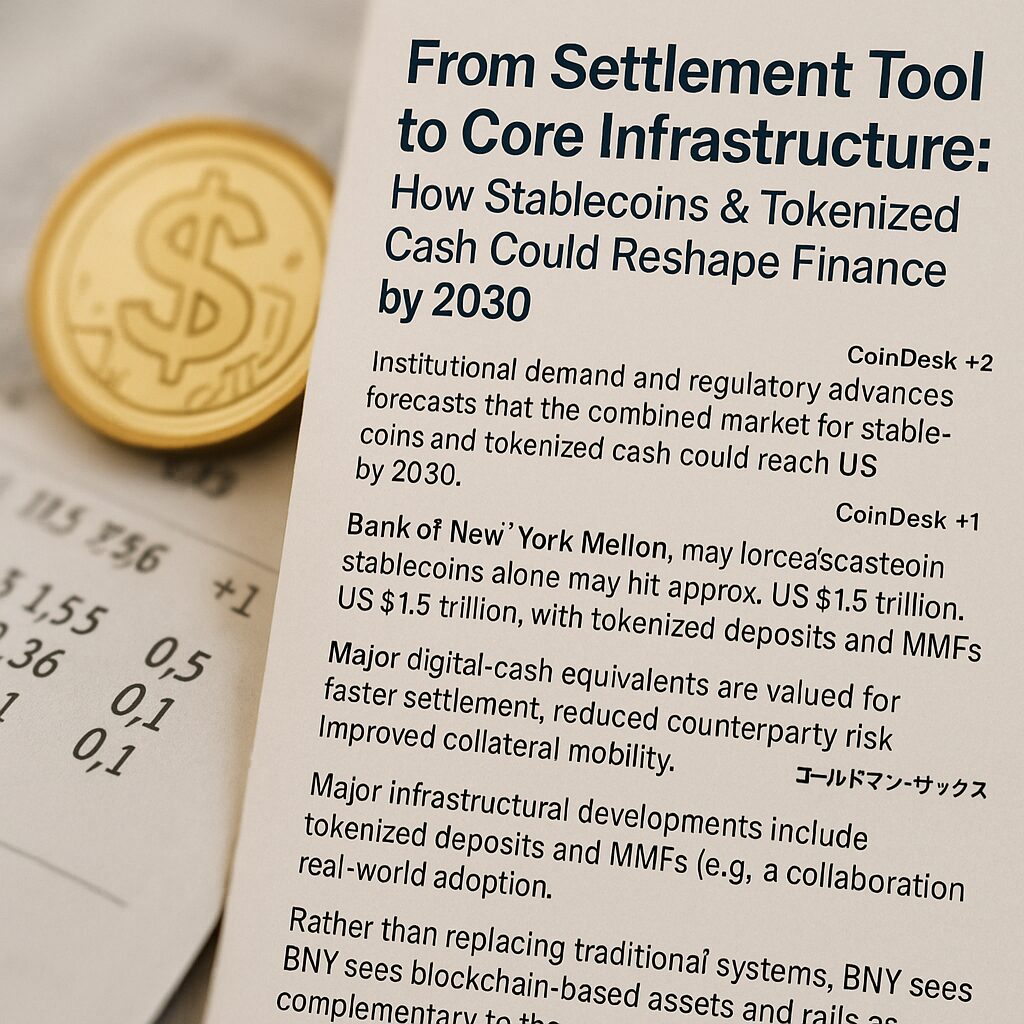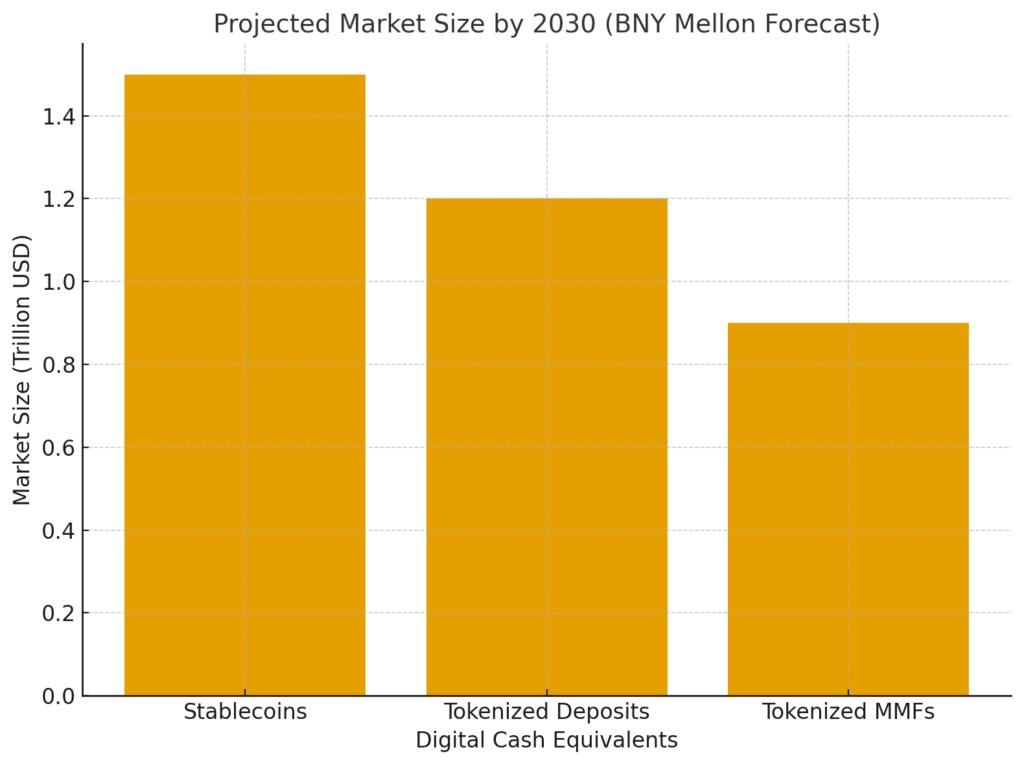
Main Points :
- Institutional demand and regulatory advances are driving forecasts that the combined market for stablecoins and tokenized cash could reach US $3.6 trillion by 2030.
- According to Bank of New York Mellon (BNY Mellon), stablecoins alone may hit approx. US $1.5 trillion, with tokenized deposits and digital money-market funds (MMFs) making up the rest.
- These digital-cash equivalents are valued for faster settlement, reduced counterparty risk and improved collateral mobility.
- Major infrastructural developments include tokenized deposits and MMFs (e.g., a collaboration between BNY Mellon and Goldman Sachs), pointing to real-world adoption.
- Rather than replacing traditional systems, BNY sees blockchain-based assets and rails as complementary to the existing financial infrastructure.
1. Growth Forecast & Why It Matters

In a recently published report, BNY Mellon projects that the market for stablecoins, tokenized deposits and digital MMFs could expand to about US $3.6 trillion by 2030. Of that total, approximately US $1.5 trillion is attributed to stablecoins alone, with the remaining US $2.1 trillion expected from tokenized deposits and MMFs.
For professionals and investors searching for “what’s next” in crypto and blockchain, this forecast highlights one of the most significant structural opportunities: digital cash equivalents beyond speculative tokens, embedded into mainstream finance. The magnitude—trillions of dollars—suggests this is not a fringe trend but a fundamental shift.
2. Key Drivers: Institutional Adoption & Regulatory Momentum
The core reasons behind the bullish projection are two-fold:
Institutional Adoption:
Large financial firms, asset managers and banks are increasingly exploring tokenized assets for treasury and collateral optimisation. For instance, tokenized deposits promise faster settlement across global payment systems, and tokenized funds offer new instruments for efficient capital usage.
Regulatory Progress:
BNY’s report emphasises that clearer regulatory frameworks are unlocking adoption. For example, in the U.S., laws like the GENIUS Act (Stablecoin Act) and in the EU, the Markets in Crypto‑Assets (MiCA) regulation, are cited as enablers of stability and innovation.
For crypto-asset seekers, the takeaway is that this is not purely about high-volatility tokens anymore—it’s about institutional infrastructure and regulatory legitimacy. Projects, tokens or platforms that align with digital cash, treasury use-cases or tokenization could have durable relevance.
3. Use-Cases: Beyond Payment Settlement to Collateral, Liquidity & Treasury
What are these digital-cash equivalents actually going to be used for?
Faster Settlement & Liquidity Mobility:
The report frames them as tools to “unlock faster settlement, reduce counterparty risk and improve collateral mobility across markets.” For example, one potential scenario: a pension fund uses a tokenized MMF to post margin for a derivatives contract in near-real time.
Treasury & Deposit Tokenization:
BNY is already testing tokenized deposits in its payments business (which handles ~$2.5 trillion daily) to enable blockchain-enabled real-time global transfers.
Tokenized Money Market Funds:
In mid-2025, BNY Mellon and Goldman Sachs launched a solution where mirror-tokens of MMF shares are created on a blockchain platform, enabling redemption and subscription via digital rails.
For someone looking into new crypto asset opportunities, consider how tokens or protocols could serve treasury services, settlement rails, collateral assets or digital versions of cash equivalents. These use-cases are moving toward real-world adoption.
4. Implications for Crypto Projects & Emerging Assets
What does this mean for new assets, tokens or blockchain infrastructure?
- Tokenization infrastructure matters: As deposit-tokens, MMF-tokens or stablecoins become more mainstream, the plumbing—asset tokenization protocols, token standards, collateral bridges—becomes valuable.
- Stablecoins evolve: While current stablecoins (~US $300 billion market) could grow to ~US $1.5 trillion, others (tokenized deposits, digital MMFs) might comprise the “next wave”.
- Integration, not replacement: BNY emphasises that blockchain-based systems will integrate with, rather than outright replace, traditional rails. This suggests solutions that bridge legacy finance and DeFi may have advantage.
- Regulation and compliance are key: Projects that build with regulatory alignment, transparent reserve backing and institutional use-cases may be more viable long-term. The academic literature supports hybrid models of fiat- and stablecoin-backed systems for resilience.
For new asset hunters: consider whether your token or protocol addresses a real-world treasury or settlement need, aligns with institutional adoption, and supports regulatory clarity. A token tied to tokenized cash deposits, settlement liquidity, or institutional collateral mobility might capture a powerful trend.
5. Areas of Risk & What to Watch
Even with the bullish forecasts, several challenges remain:
- Regulatory uncertainty remains: While frameworks are advancing, global regulatory alignment is still incomplete; stablecoins and tokenized assets face scrutiny around reserve backing, redemption rights and systemic risk.
- Technology and infrastructure scale: Blockchain systems and tokenization platforms must scale to support trillions of dollars in value with high reliability and security.
- Adoption inertia: While there are pilots (tokenized deposits, MMFs) the full ecosystem is still nascent; bridging legacy systems and achieving network effects could take time.
- Token-specific risks for investors: New assets tied to tokenized cash equivalents may face risks around reserve operations, issuers’ creditworthiness, liquidity and integration with traditional finance.
For practitioners and investors: monitor how regulation evolves (e.g., stablecoin laws, token-asset frameworks), how major banks move (BNY, Goldman, BlackRock), and what token-platforms gain institutional usage or partnerships.
6. What to Do Now: Strategic Moves for Blockchain & Crypto Practitioners
Given this landscape, here are practical suggestions:
- Explore tokenization protocols: If you are designing wallets, swaps, or blockchain tools (as you are with “dzilla Wallet”), consider enabling tokenization or settlement-rail features for deposits and cash equivalents.
- Align with treasury use-cases: Focus on tokens that serve institutional treasury flows, cross-border settlement or collateral mobility rather than purely speculative assets.
- Watch partnerships and frameworks: Track collaborations (e.g., BNY + Goldman) and institutional infrastructure builds; being early in a stack that supports tokenized cash could position you ahead.
- Consider regulatory alignment early: For a project seeking real-world usage, ensuring reserve auditability, compliance, and institutional standards may differentiate you in a crowded token market.
- Identify niche tokens in the cash-equivalent space: While stablecoins are crowded, tokenized deposits or tokenized MMFs may be less explored from a crypto-asset perspective—there may be revenue-opportunity angles here.
Conclusion
The projection from BNY Mellon—that stablecoins and tokenized cash equivalents could reach a US $3.6 trillion market by 2030—signals a major shift in how value moves globally. For readers searching for new crypto assets or blockchain applications, the implication is clear: the next wave is not just about volatile tokens, but about digital cash infrastructure, institutional use-cases and integration with traditional finance. Tokens or platforms that serve treasury flows, collateral mobility, settlement speed and regulatory compliance may capture this trend.
As you develop, design and evaluate tools like your upcoming wallet, consider how they can serve as bridges between legacy systems and blockchain rails. The era of institutional digital cash is approaching—and positioning early in tokenization, settlement infrastructure and real-world use may provide compelling upside.

